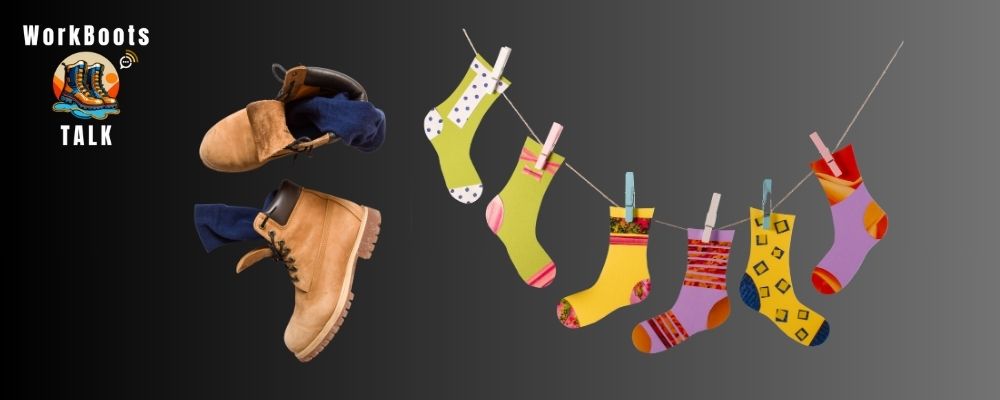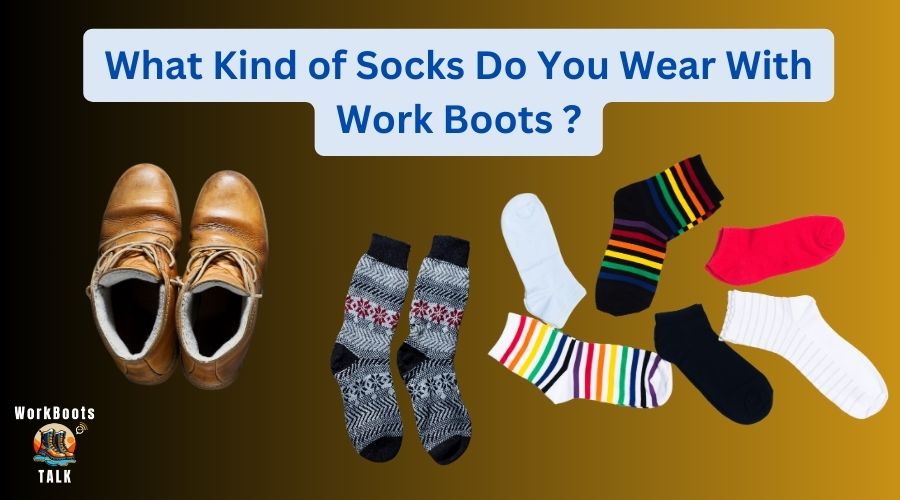In a demanding work environment, wearing the appropriate attire is crucial for protection and peak performance. Specifically, your work boots play a vital role. They’re designed to ensure comfort, support, and safety for your feet. But, overlooking the importance of pairing them with the right work socks can lead to discomfort and problems.
Work socks are far from ordinary. They’re expertly engineered to meet the needs of those who endure prolonged periods on their feet, whether on construction sites or during a rigorous day of hiking. The right pair of socks can have a substantial impact on foot comfort, warding off blisters, combatting stinky feet, and preventing fungal infections. Crew socks that rise just right on the calf, integrated with features like ribbing for fit and elastane for stretch, are ideal for heavy-duty boots.
So, how do you select the ideal work socks for your boots? What aspects should you consider, and what are the optimal materials, thickness, and length? This article will provide insights and answers, helping you discover the perfect work socks for your needs.
High-quality boot socks not only provide foot coverage but offer more.
Selecting the right socks to wear with your work boots transcends mere comfort – it’s about safeguarding your health and safety, too. Beyond just covering your feet, socks serve as critical protectors, addressing various issues that could mar your performance and overall well-being.
The Role of Socks in Foot Health and Comfort
Socks act as a shield, providing insulation that reduces the harsh skin-to-shoe contact, thereby cutting down on friction and warding off blisters. They soften the blow of each step, thanks to their shock-absorbing properties, elevating your comfort levels. Additionally, socks play a key role in regulating your feet’s temperature and moisture—keeping them warm when it’s chilly and cool under the scorching heat. The use of breathable and moisture-wicking materials in socks is crucial as it helps prevent sweaty feet, which can lead to odors, fungal infections, and other discomforts. Socks also adapt to the movement of your feet, protecting them from the static nature of shoes as they expand and morph with every step.
Features to Look For in Quality Work Boot Socks
In the quest for the best work boot socks, prioritize these essential features:
- Materials: Choose from wool socks for their natural temperature-regulating properties, or synthetic fibers such as Lycra for elasticity. Blended materials including elastane provide flexibility, ensuring each pair of socks conforms to the contours of your feet.
- Length: Crew socks or long socks extending to calf or mid-calf offer optimum coverage, while no-show socks might be preferred in casual footwear.
- Cushioning: Adequate padding in the insole area is paramount, while your soles will appreciate a fine yarn knit for breathability.
- Compression: Consider compression socks to promote circulation, especially for those on their feet all day.

What Are Good Boot Sock Materials?
Choosing the right material for your work boot socks is essential for both your foot health and comfort. Opt for wool socks when traversing cooler climates or if you’re planning a hiking adventure, as wool’s threads offer exceptional thermal socks qualities. In contrast, synthetic fibers like elastane are excellent for maintaining the sock’s shape and offer a snug fit without constriction.
Merino Wool: The All-Weather Wonder
- Merino wool, a natural fiber from the merino sheep, thrives in extreme climates, making it exceptionally versatile.
- Unlike traditional wool, merino wool is soft, fine, and non-itchy. Its stand-out feature is its thermal regulation: it keeps your feet warm when it’s cold and cool during hotter periods.
- Moreover, merino wool excels in moisture-wicking, absorbing sweat swiftly to prevent odor and fungal infections.
- Being biodegradable and eco-friendly, merino wool is a sustainable pick for eco-conscious consumers.
Synthetic Fabrics for Durability and Moisture Management
- Synthetic fabrics, including polyester, nylon, acrylic, and spandex, are man-made and chemically derived.
- These fabrics are typically more affordable and boast greater durability and wrinkle resistance than natural options.
- They shine in moisture management, quickly wicking away sweat to keep feet dry and reduce blister and odor risks.
- However, they may lead to overheating, irritation, and odor without proper breathability or in combination with other materials.
- Unlike their natural counterparts, synthetic fabrics are not biodegradable and pose environmental pollution concerns.
The Blend: Combining the Best of Both Worlds
- Blends mix various fibers—like cotton, wool, polyester, and nylon—to harness the benefits of both natural and synthetic materials.
- This combination can offer superior comfort, breathability, durability, and moisture-wicking properties.
- Additionally, blends can mitigate drawbacks associated with individual materials, such as wool’s itchiness, polyester’s heat retention, or cotton’s tendency to shrink.
- Blends also allow for a diverse range of textures, colors, and patterns, offering a flexible solution for both style and functionality.
Choosing the Perfect Sock Thickness and Length
When it comes to work boot socks, thickness and length are crucial factors that influence your comfort, fit, and protection. Discover how to select the ideal sock thickness and length for your boots, enhancing your workday experience.
Thickness: Balancing Cushioning with Boot Fit
The thickness of your socks plays a significant role in providing cushioning and insulation for your feet. While thicker socks offer more comfort and warmth, they might also lead to a tighter fit and decreased breathability in your boots. On the other hand, thinner socks are lightweight and promote better airflow, yet they might result in increased friction and reduced shock absorption.
Finding the perfect sock thickness hinges on the design and fit of your boots, alongside considerations like weather conditions and personal comfort preferences. For boots that fit snugly, lean towards thinner socks to prevent overcrowding your feet. Conversely, if your boots offer extra room, thicker socks can help fill the void and stop your feet from sliding.
Weather also plays a pivotal role; colder climates may necessitate thicker socks for added warmth, whereas hotter environments might call for thinner options for better cooling and moisture management. Remember, layering socks of different thicknesses can be a strategic way to achieve the right balance between cushioning and a good fit.
The Big Deal About Length: Why It’s More Important Than You Imagine
The length of your socks is another essential aspect that determines coverage and support for your legs. Work boot socks typically extend to calf-length or mid-calf to cover the boot’s shaft adequately and avert any rubbing or chafing.
Depending on your preference, you might opt for over-the-calf or knee-high socks for additional warmth and support. The most suitable length for your socks is influenced by your boots’ height and style, the nature of your work, and your personal liking. For high-cut boots, longer socks are advisable to match the boot’s height and protect your skin. If your boots are of a lower cut, choosing shorter socks can help minimize extra material and bulkiness.
In environments with rough terrain or when working with heavy machinery, longer socks offer enhanced protection and compression, whereas jobs in smoother areas or with lighter equipment might benefit from the flexibility and breathability of shorter socks. Don’t forget, alternating sock lengths based on the season and prevailing weather conditions is also a smart approach.

Tips for Sock Maintenance and Longevity
Maintaining your work boot socks is key to ensuring their longevity and optimal performance. Consider the following tips for proper care:
Proper Washing and Drying Techniques:
- Machine wash socks according to care instructions, using a gentle cycle to prevent damage.
- Avoid using bleach or fabric softeners, as they can break down fibers and reduce sock effectiveness.
- Air-dry socks whenever possible to prevent shrinkage and maintain fabric integrity.
Storage Considerations to Prevent Wear and Tear:
- Store socks in a cool, dry place to prevent the growth of mold and mildew.
- Keep socks away from direct sunlight to preserve colors and prevent fading.
- Store socks individually or in pairs to maintain their shape and prevent unnecessary stretching.
When to Replace Socks for Optimal Performance:
- Replace socks if you notice signs of wear, such as thinning fabric or loss of elasticity.
- Optimal performance is compromised when socks no longer provide proper cushioning or support.
- Regularly assess sock condition and replace as needed to ensure ongoing comfort and foot health.
- By adhering to these maintenance tips, you can extend the life of your work boot socks, ensuring they continue to provide the support and comfort required for your demanding work environments.
Stepping into Comfort and Performance: The Final Stretch
Choosing the right socks for work boots might seem like a simple task, but it’s a pivotal decision that impacts your entire workday. Ditch the blisters, chafing, and fatigue, and step into a world of comfort, performance, and foot health by remembering these key takeaways:
Match your socks to your work environment:
Consider the temperature, moisture levels, and specific demands of your job. Opt for breathable fabrics in hot weather, insulating socks for the cold, and waterproof options for wet conditions.
Prioritize material and thickness:
Choose durable materials like nylon or wool for heavy labor, moisture-wicking fabrics like Coolmax for sweaty jobs, and cushioned socks for long hours on your feet.
Maintain and replace with care:
Wash and dry your socks properly, store them neatly, and know when to let go of worn-out pairs. Taking care of your socks keeps them performing at their best and keeps your feet happy all day long.
Investing in the right work boot socks is an investment in your comfort, health, and job satisfaction. By prioritizing these considerations, you can transform your workdays from a painful slog to a confident stride, conquering every challenge with ease and foot-tastic comfort. So, lace up your boots, slip on the perfect pair of work boots socks, and step into a workday filled with productivity and well-being!
Conclusion
Finding the ideal work socks to pair with your boots is far from a simple decision. This choice is crucial for ensuring your foot health, comfort, and performance. It’s important to evaluate the material, thickness, and length of the socks, alongside the fit and style of your boots, prevailing weather conditions, and your own personal preferences. The Superior work socks are those that offer cushioning, insulation, moisture-wicking capabilities, durability, and odor resistance.
Equally, they should align seamlessly with your boots to avoid any uncomfortable rubbing or chafing. Merino wool, synthetic fibers, or a combination of both stand out as the best materials for work socks. Optimal lengths usually extend to calf-length or mid-calf length, tailored to the height of your boots and your specific job requirements.
For those in search of the ultimate work sock match for their boots, our sock finder size chart and the opportunity to explore our gift cards chance socks await. You might also find interest in our premium selection of work socks from reputable brands such as River Fox, Darn Tough, and Carhartt. Don’t compromise on average socks that could compromise your feet and your day. Commit to the best work socks for your boots for an unrivalled blend of comfort, protection, and style.
Frequently Asked Questions
1. Are boots meant to be worn with thick socks?
Boots can be worn with various sock thicknesses based on preference. It’s about finding a balance for desired comfort and support.
2. What socks should be worn with work boots in summer?
Choose breathable and moisture-wicking socks, like cotton blends or lightweight synthetics, for cool and comfortable feet in summer.
3. Can you wear normal socks with work boots?
Yes, regular socks are fine. However, for optimal comfort, consider socks with features like moisture-wicking and cushioning during extended wear.
4. What is the purpose of boot socks?
Boot socks are designed for comfort, support, and durability. They often feature materials and construction that address the specific demands of wearing boots, ensuring a better overall experience.
5. Can the right socks contribute to overall foot health?
Absolutely. Properly chosen socks provide support, prevent blisters, and contribute to a comfortable and healthy foot environment, positively impacting overall foot health.
6. Is there a specific time to replace work boot socks?
Yes, replace socks when you notice signs of wear, such as thinning fabric or loss of elasticity. Regular assessment ensures ongoing comfort and support.
7. What kind of socks do you wear with boots?
The ideal socks for boots are those with features like cushioning, arch support, and proper thickness. Look for materials that suit the climate and demands of your work, such as moisture-wicking blends or insulating wool.
8. Are cotton socks good for work boots?
While cotton socks are breathable, they may retain moisture, making them less ideal for work boots. Moisture-wicking materials like synthetic blends or wool are generally recommended for better comfort and foot health.
9. What are socks for boots called?
Socks designed for boots are often referred to as boot socks. These socks are crafted with specific features to enhance comfort, durability, and performance when worn with various types of boots.
10. Should I wear two pairs of socks with work boots?
Wearing two pairs of socks can provide extra insulation in cold weather. However, it’s essential to ensure that the combination doesn’t compromise the fit of your boots, leading to discomfort or circulation issues.
11. What type of socks should you wear with work boots?
Select socks made from moisture-wicking materials, such as blends with synthetic fibers or merino wool. These materials help keep your feet dry and comfortable throughout the day.
12. What are the best work socks for sweaty feet?
Opt for moisture-wicking socks with breathable materials like merino wool or synthetic blends. Look for features like ventilation channels or mesh panels to promote air circulation and keep sweaty feet dry.
Choosing the right socks for work boots involves considering factors like material, thickness, and specific features to ensure optimal comfort and performance in various work conditions.


What a valuable knowledge you have shared. Every single thing explained at minute level. #Great blog